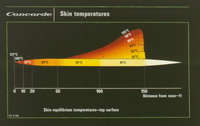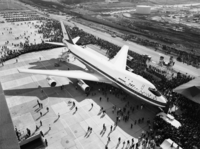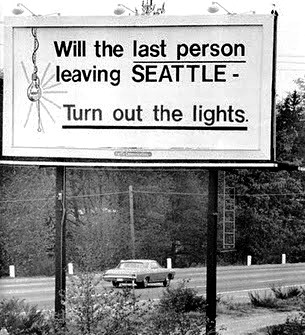Part 33: Interlude: Concorde/ Boeing 747 (Spaced God)
I emerge from Midterms and Spring Break (And my college winning a great basketball game) in a drunken stupor. Time to teach y'all about airplanes, and a two-for-one special no less!Most refer to the 60's as the "Golden Age" of air travel, and they'd be pretty fucking right. Tickets were finally becoming relatively affordable (I say relatively because the price was still five times what it is now. Tickets back then often costed 5% of a year's salary
 ), and the planes were able to get more people and things to their destinations faster. It also acts as good point in time to describe the split in the thinking of aircraft designers: going fast or going big. Each have their own problems, and those problems get exponentially amplified the more in one direction you go. So, let's explore two of the most iconic aircraft of commercial aviation (note: each aircraft has a fuckton more history about the design and in some cases lengthy arguments about the usage of the letter e. But, you have lives so I'll skip that):
), and the planes were able to get more people and things to their destinations faster. It also acts as good point in time to describe the split in the thinking of aircraft designers: going fast or going big. Each have their own problems, and those problems get exponentially amplified the more in one direction you go. So, let's explore two of the most iconic aircraft of commercial aviation (note: each aircraft has a fuckton more history about the design and in some cases lengthy arguments about the usage of the letter e. But, you have lives so I'll skip that):Part 1: GOTTA GO FAST

The idea of a supersonic transport (SST for short) had been around for about as long as we had been flying, since the concept of "go faster" is apparently human's instinct when it comes to travel. The first serious looks were given to the idea in the beginning of the 1950s, not long after Gen. Yeager took the X-1 past the sound barrier with two broken ribs and a broomstick (a story for another time). Supersonic fighter aircraft were becoming more and more commonplace, and the designers and engineers were starting to understand what effects supersonic flow had on designs. Welsh Engineer Morien Morgan had been commissioned to perform a study on SSTs in 1950, in which he determined one of the main sticking point would be the amazing amount of power and fuel required to propel a passenger plane beyond the speed of sound for long periods of time. He said it would "result in some horribly large aeroplanes," and considered the idea unfeasible.
Six years later Morgan (under directive by the Crown) put together a new committee called the Supersonic Transport Advisory Committee to figure out how the fuck to make these aircraft feasible. Their goal was to make an aircraft that was economically comparable to its subsonic counterparts (assuming that the massive fuel costs would be counteracted by a greater number of flights in a given time), fly across the atlantic at Mach 2, carry 150 passengers, and cost about 75-90 million pounds. Contracts were awarded in 1959 to the British Aircraft Corporation (comprising of several UK aircraft companies), who in turn started discussing the idea with and Sud (later named Aerospatial).
In 1960 the French (who had SST ideas of their own) joined up with BAC via government-owned Aerospatial and the SST aircraft was dubbed Concorde, meaning unity. Two prototypes were built in 1969 -- one British, one French -- and Concord went on a world tour to demonstrate its capabilities and sell aircraft. Before the wheels had even left the ground, BAC and Aerospatial had 74 orders from 16 airlines.
Here's where I have to mention some problems of flying past the sound barrier. I mentioned a big one at the beginning: it's fucking expensive to maintain, fuel, and design. On top of that, shit gets hot at Mach 2, so you have to account for thermal expansion and other fun heat things (Concorde grew 6 inches during flight and had refrigerated windows so passengers didn't burn their hands on the 100C skin). The engines were massively loud, and the sonic booms were feared and despised. Most everyone thought fought Concorde landing at airports near their houses, and backed up their concerns with strange claims (deafening their children, giving them x disease, and even disrupting someone's rhythm method and getting their wife pregnant). There's one last big gleaming issue that helped kill the idea of SST, more on that later though.

Concorde gets fucking hot
Concorde entered service in 1976 with London-Bahrain, Paris-Rio, and Paris-Caracas routes. US Congress banned the Concorde due to protests over noise concerns, but made special exception for JFK and Washington-Dulles airports. Tickets were ungodly expensive (about $12,000 round-trip) and even then the airlines were taking heavy losses on the flights. They tried to make the price seem more appealing by offering lavish services such as a menu of caviar, lobster, champagne and Cuban cigars. Moreover, an SST was seen as a gimmick and airlines didn't want one even if it was profitable. And there lies the biggest problem: no one WANTED the fucking thing. Airlines cancelled their orders and put BAC/AS up shit creek with no paddle and no money. Post-9/11 air travel fears, rising maintenance costs, and other better rival aircraft all tightened the noose more and more on the aging aircraft, until it was finally retired in 2003. Only 14 aircraft ever flew commercially, and all but two are either under restoration or on display in museums. Private rich dudes are trying to bring the aircraft back into charter service, but private rich people have more dollars than sense.
https://www.youtube.com/watch?v=YeEB2Lxbfa4
A flight from inside the Concorde, featuring a very informative pilot
Part 2: Let the Queen Fly, or Seattle Fall
Across the pond, Boeing was in dire straits. The company that was one of the biggest employers in the Seattle-Tacoma area had just lost out on a big heavy lifting contract for the USAF to Lockheed's C-5 Galaxy, and rumors were abound that Congress was cancelling their rival SST (aptly named the Boeing SST) before prototypes could even be built. Orders on their airliners were falling, and many thought the company may not be around much longer at this rate. Not to be counted out yet, Boeing bet their company on an idea: Make their heavy lifter an airliner. Changes were made, seats were added, and a full-length double deck was turned a half-length one to create a distinctive top-bulge. By mid-1966, the nicknamed "Queen of the Skies" began to take shape, and airlines liked what they saw. Pan-Am bought one, with a delivery date by the end of 1969. Boeing had to finish designs of an entirely new aircraft, test it, certify it, and deliver it all in 28 months. I think this is the definition of "crunch time."
The prototype was absolutely massive: 60 meters wide, 70 meters long, weighing more than 162 metric tons empty and capable of taking 480 passengers intercontinental in luxury. The plane was both wider and longer than the Wright's first flight at Kitty Hawk. The aircraft was so big, in fact, a new 100 acre building had to be built to accommodate an assembly line for these aircraft. But, there wasn't enough time to finish the building and build the testing vehicles, so the latter were built before a roof was on the former. Money was running low and employees were working 80 hour weeks to finish the project. By the end of September 1968 the first prototype rolled out on display to the public. 26 airliners placed orders, and the airliner entered service in January 1970. Orders were coming in, and maybe in a few years the project will break even. Boeing had even begun to recover some of it's $2B dollar debt it accrued from the project. The gamble looked like it had worked.

The first 747 on display
But of course something had to fuck up. In 1970 there was a massive recession and the aviation industry came down with it. From September 1970 to March 1972 there were 2 orders placed for a 747. The SST was cancelled for realsies in 1971, cutting Boeing employees from 100,000 to 32,000. The unemployment rate in Seattle was double what it was elsewhere in the country. The situation looked so dire someone bought a billboard on the outskirts of town by the Everett factory: "Will the last person leaving Seattle turn out the lights"

Engine deficiencies had crippled deliveries of the new orders, but Boeing persisted. It modified the design, giving it better economy and more carrying capacity. As the recession ended, more and more people began to take to the skies and the order poured in. Contracts were given from NASA, the DoD, The Air Force (including the two aircraft used for carrying the President), and any rich dude with $350M. Seattle bounced back, and along with it Boeing. 1,500 aircraft have been delivered to date across 8 major variants. The 747 is considered to be one of the biggest airliner successes in recent history. The gamble finally, truly paid off.
So there you have it. Two very different aircraft, each at opposite ends of the spectrum. One was seen as the future and projected to be a success, the other an underdog from a dying company with massive carrying capacity. Hopefully you guys don't mind me writing 1500 words
 ing out about airplanes, but I find it fun. Gives me an excuse to let out my alter-ego as a mild-mannered airplane museum tour guide.
ing out about airplanes, but I find it fun. Gives me an excuse to let out my alter-ego as a mild-mannered airplane museum tour guide. And yes, this was all a roundabout way to say "747's over Concordes, Jaguars!"